Investment. What the "Crimean" Federal Target Programme Finances / 2014-2021
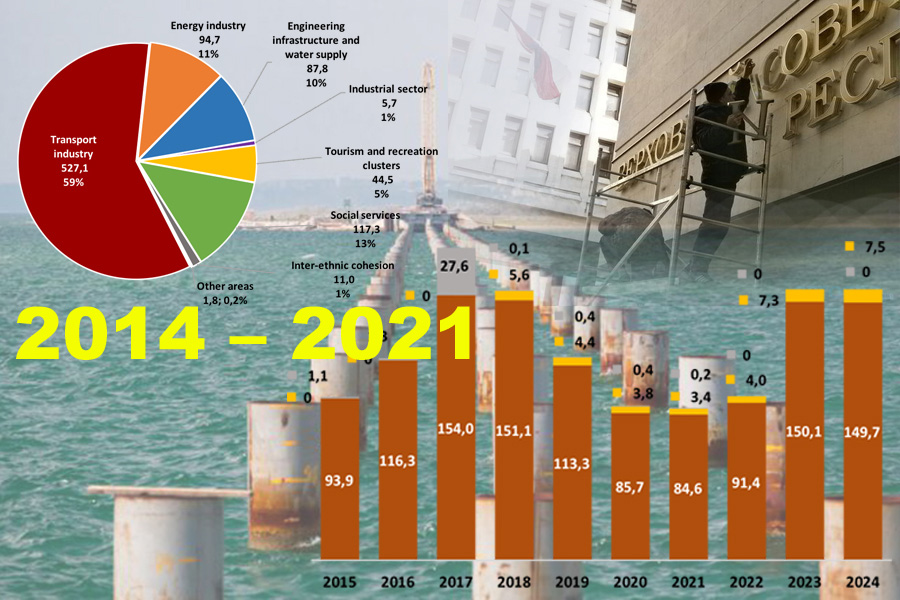
The Monitoring Group of BlackSeaNews
and the Black Sea Institute of Strategic Studies
presents an updated series of articles
«The Socio-Economic Situation in Occupied Crimea in 2014 – 2021»:
Back in the USSR. The Reverse Restructuring of the Crimean Economy / 2014-2021
The "Trophy Economy". Militarization as a Factor of Industrial Growth / 2014-2021
The "Trophy Economy". The Development of the Stolen Ukrainian Black Sea Shelf / 2014-2021
The Crimean "Trophy Economy": The Sale of Ukrainian Property. An Updated Review for 2014 – 2021
The Occupied Crimean Tourism / 2014-2021
Occupied Crimea. Exports and Imports / 2014-2021
The Banking System of Crimea: What is Really Happening on the Occupied Peninsula (Updated)
Investment. What the "Crimean" Federal Target Programme Finances / 2014-2021
«Migration weapons»: the replacement of the Crimean population with Russian
Water in Occupied Crimea / 2014-2021
The Crimean Budget. Small Business. Salaries and Pensions / 2014-2021
* * *
Investment
According to Rosstat, during the years of the occupation, investment in fixed capital in Crimea and Sevastopol has totalled $11.0 billion and $2.2 billion respectively. Of this investment, $7.5 billion (68%) in Crimea and $1.6 billion (73%) in Sevastopol were funded from the state budget (see Chart 1).
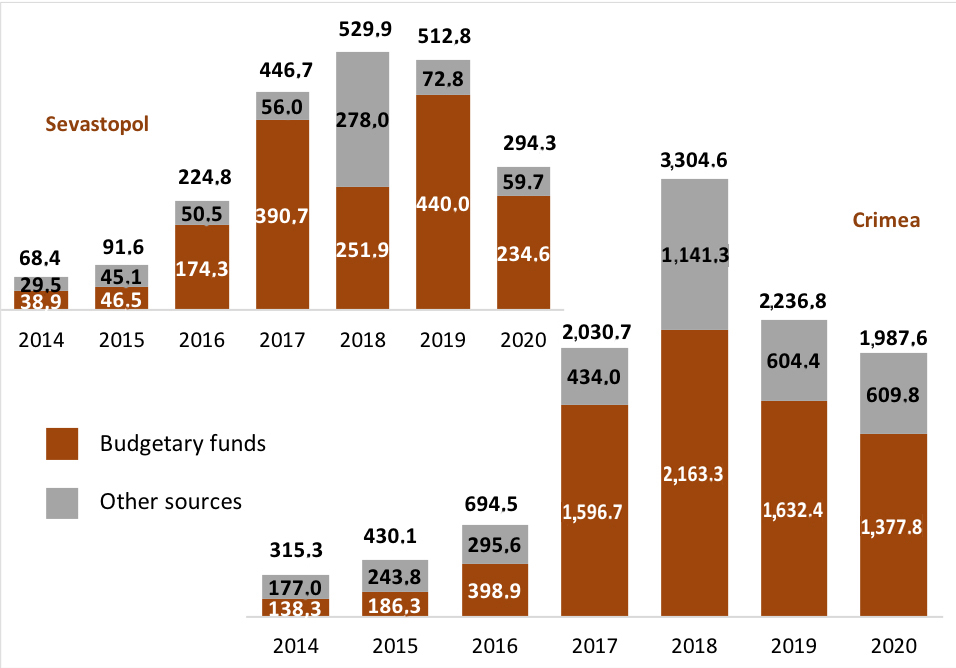
This was mainly the investment in the facilities under the so-called Federal Target Programme "The Socio-Economic Development of the Republic of Crimea and Sevastopol until 2025" (the FTP).
The correlation between the level of financing capital investment under the Federal Target Programme and the amount of investment according to official statistics is shown in Chart 2.
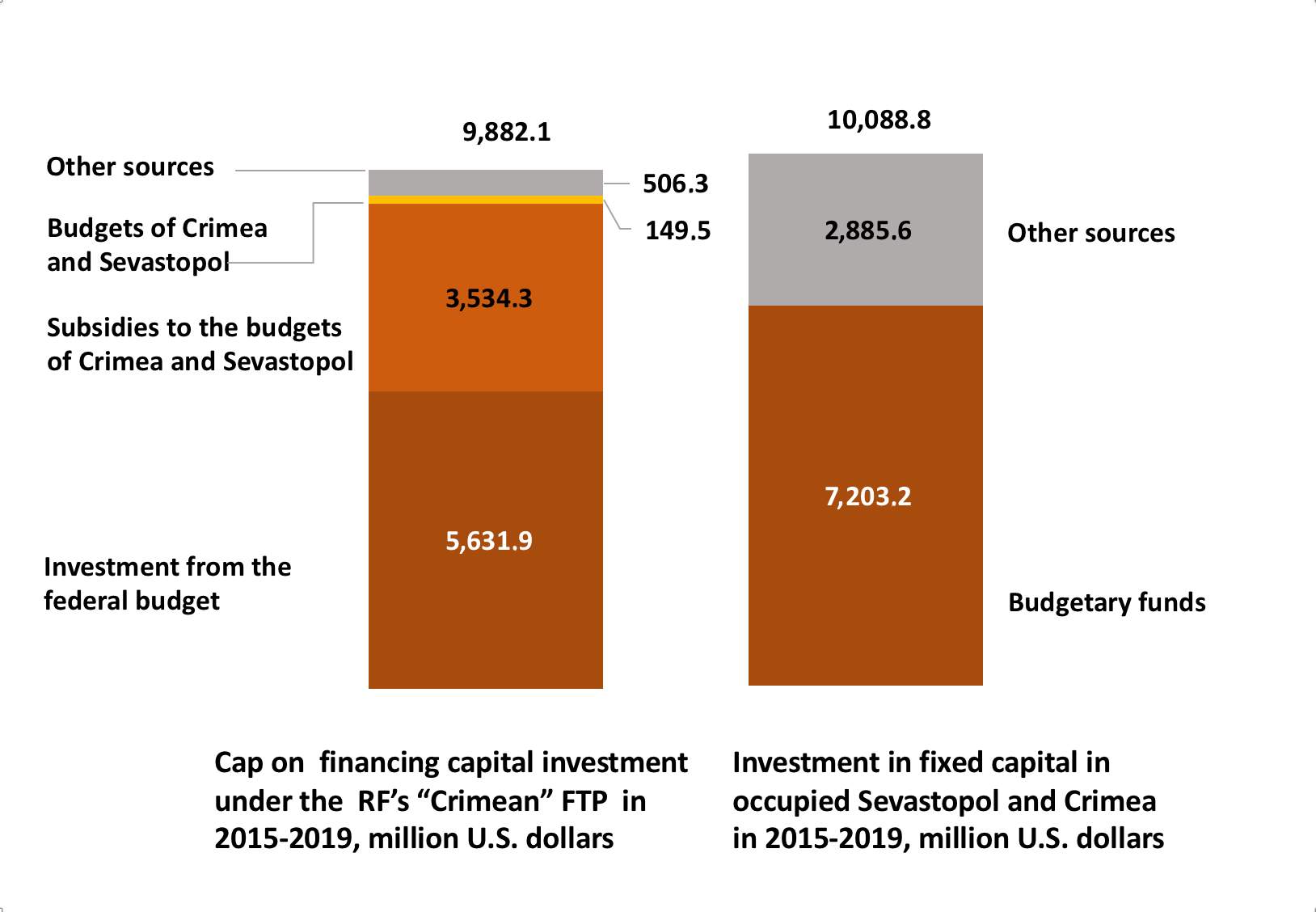
In addition to 70% of budget investment in fixed capital, in Figures 1 and 2 we can see investment "from other sources".
The "other sources" of investment in Crimea and Sevastopol are as follows:
-
investment in the construction of road and energy infrastructure, other facilities under the FTP, the funds for which were allocated not directly from the budget of the Russian Federation, but through Russian state and quasi-private corporations or bank loans;
-
investment from enterprises of the military-industrial complex of the RF in military production at Ukrainian plants seized as a result of the occupation;
-
private investment in housing construction for customers from the RF is almost the only type of demand-oriented investment projects. The customers, in turn, represent a specific group of Russian military and government officials transferred to the peninsula. Also, private investment in trade and warehouse infrastructure of wholesale and retail businesses from the regions of the RF is made.
What the "Crimean" Federal Target Programme Finances
The Russian Federal Target Programme "The Socio-Economic Development of the Republic of Crimea and the City of Sevastopol until 2020" was adopted in August 2014, adjusted several times, and finally extended until 2025.
The planned amount of funding for the programme as of 23 April 2021 was 1373.6 billion roubles, including 1302.7 billion roubles from the federal budget, 39.8 billion roubles from the budgets of the “constituent entities of the Russian Federation”, 311.2 billion roubles from extrabudgetary funds.
Capital investment under the programme amounts to 1240.9 billion roubles, the remaining 132.7 billion roubles have been allocated for “other needs", such as urban planning documentation, the Era-Glonass system, the creation of communication channels "for the benefit of the Ministry of Defence of the Russian Federation, federal executive bodies, other bodies and organizations, communications operators to ensure national security and defence and law enforcement".
As for the goals of the Federal Target Programme and the specific projects that have been funded, the main objective of the programme is to remove the infrastructure constraints that have arisen as a result of the occupation of Crimea. They are:
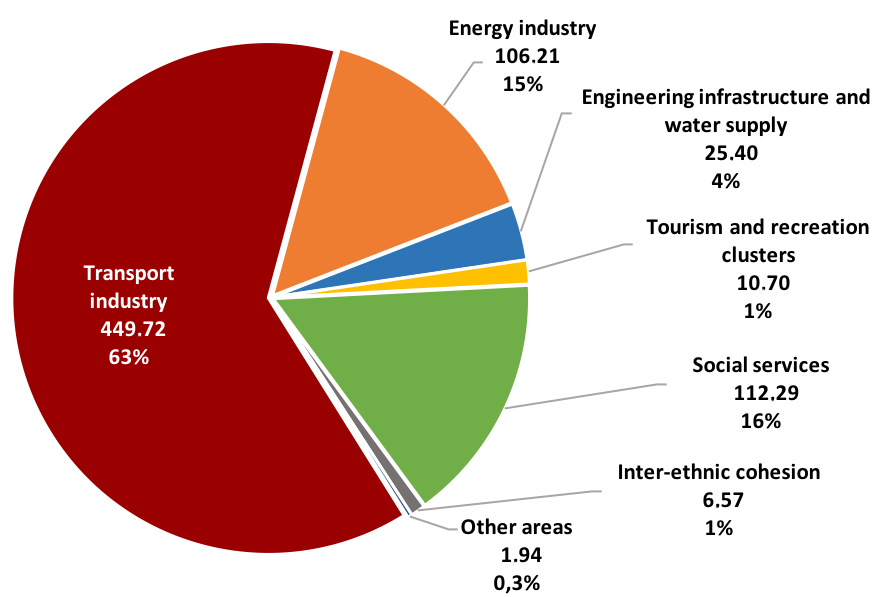
the removal of transport infrastructure constraints: the construction of the bridge across the Kerch Strait, the reconstruction of Simferopol airport, the construction of roads to increase transport accessibility of the Crimean Peninsula, and reformatting the existing transport corridors for passenger and freight traffic with the focus on Russia, the arrangement of checkpoints (about 63% of the funds);
-
the removal of energy supply constraints: the removal of network constrains, own energy generation (at least 15% of the funds);
-
the removal of engineering infrastructure constraints: the creation of a water supply system (at least 4% of the funds).
Other areas of funding have big names, however, far less funds have been allocated for them:
-
the formation of an industrial complex, i.e. the creation of the infrastructure for industrial parks (0.2%);
-
the formation of tourist and recreational clusters (1.5%);
-
social services (15.7%);
-
ensuring inter-ethnic cohesion (0.9%);
-
the protection of the population and territories from emergencies and other areas of funding account for only 0.032% of the amount of capital investment.
The latest funds added to the amount of funding for the programme in 2020–2021 were not allocated for specific purposes, so the structure of funding for the Federal Target Programme today looks as shown in Chart 4.
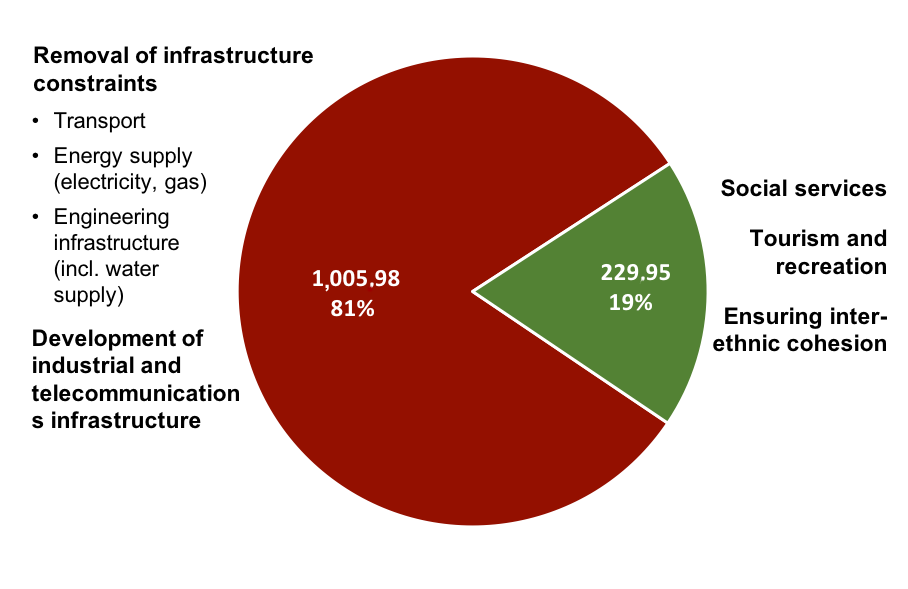
It is clear that the priorities have not changed: megaprojects to overcome infrastructure constraints and measures to create telecommunications and industrial infrastructure account for more than 80% of the funds.
The main source of funding for the target programme has been and will remain the federal budget of Russia (see Chart 5). Funds from extrabudgetary sources of the FTP are defined in the programme as "credit, various types of loans, as well as own funds of investor companies.”
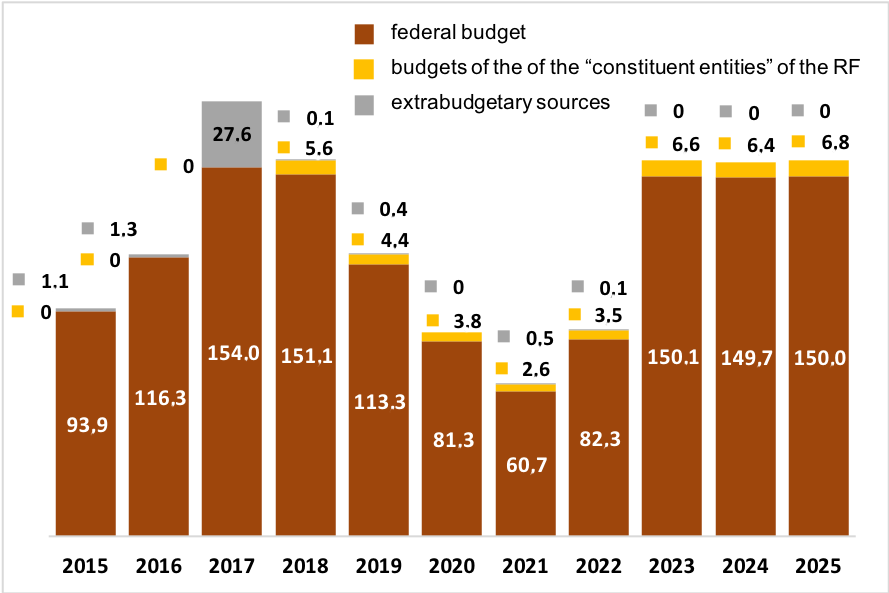
* * *
Thus, the real nature of investment in the occupied territory indicates that under international sanctions Crimea by definition cannot become attractive for investors. It has been and will remain a financial burden for the budget of the occupying power.
* * *
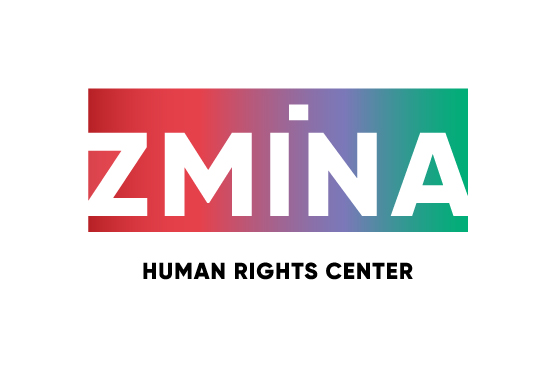
This article has been published with the support of ZMINA
Human Rights Centre.
The content of the article is the sole responsibility of the authors.
More on the topic
- 21.08.2023 Peculiarities of the 2023 Crimean Holiday Season — a «Tourism» in Camouflage
- 06.08.2023 Crimea During the Great War. Part 2. Extreme Tourism or «New Types of Tourism» and Tourist Numbers (2)
- 21.07.2023 Crimean Titan: Under a Russian Holding or a Ukrainian Tank?
- 12.06.2023 Crimea during the Great War. The situation in the occupied Crimea in 2022-2023. Military Context (1)
- 23.11.2021 Occupied Crimea. Exports and Imports / 2014-2021
- 23.11.2021 Water in Occupied Crimea / 2014-2021
- 23.11.2021 The Crimean Budget. Small Business. Salaries and Pensions / 2014-2021
- 23.11.2021 The "Trophy Economy". The Commercial Exploitation of Marine Biological Resources in the Black Sea and the Sea of Azov / 2014–2021
- 21.11.2021 The "Trophy Economy". Militarization as a Factor of Industrial Growth / 2014-2021
- 21.11.2021 Back in the USSR. The Reverse Restructuring of the Crimean Economy / 2014-2021
- 20.11.2021 The "Trophy Economy". The Development of the Stolen Ukrainian Black Sea Shelf / 2014-2021
- 20.11.2021 The Occupied Crimean Tourism / 2014-2021